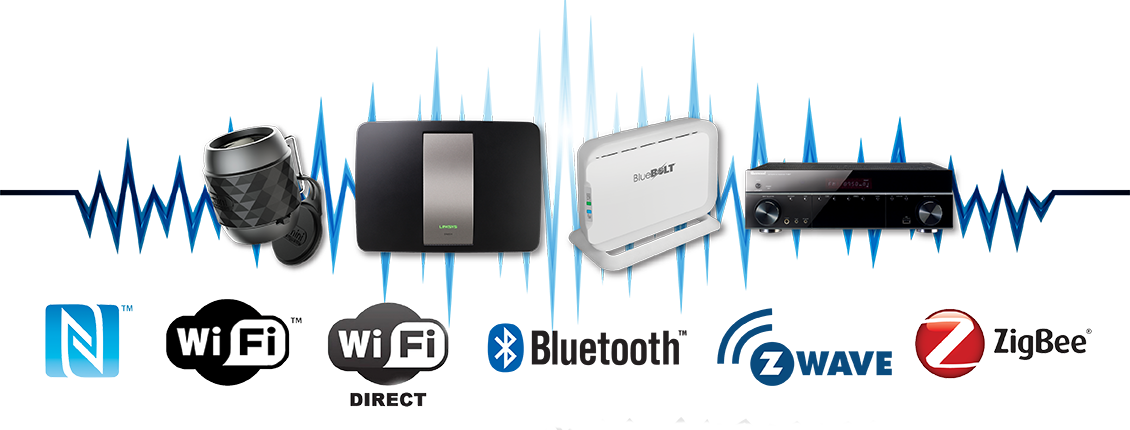
Deciphering the alphabet soup of wireless standards
Updated June 28, 2019: Programmable houses.
Cell phones that double as wallets.
Music systems that play customized audio in every room.
Wireless is everywhere. Your business depends on it. Everything from smartphones to thermostats are crammed full of wireless technology. WiFi, Zigbee, Z-Wave, Bluetooth, NFC, and more are all a part of the IoT—Internet of Things.
Sometimes even we in the business have trouble keeping the acronyms straight. Therefore, you know your customers are clueless.
Use quick review to help you and your sales staff answer questions from your customers—as well as refresh your own memory.
Wireless standards: Bluetooth
Bluetooth began in 1994 with phone maker Ericsson. The Swedish company wanted a wireless alternative to RS-232 data cables. Instead, they created the most ubiquitous of the many wireless standards on the planet.
Bluetooth enables devices to communicate with each other. There are Bluetooth standards as well as Bluetooth profiles. What’s the difference? The standards provide the broad technical parameters. 5.1 is the latest. Profiles are applications and behaviors that work with a standard. Of course, they have abbreviations associated with them.
Popular profiles include:
- A2DP (Advanced Audio Distribution Profile—or Bluetooth audio streaming)
- AVRCP (Audio/Video Remote Control Profile—single remote controls all A/V equipment, commonly used in cars)
- HFP (Hands-Free Profile—communication of car hands-free kits with cell phones)
- HDP (Health Device Profile—transmission of health data to smart health device)
- BAP/PBA (Phone Book Access Profile—also used in cars to display name of incoming caller or download a phone’s address book to initiate calls from the car display)
Bluetooth is now the de facto standard for most wireless accessories. Range and bandwidth are its main limitations. Maximum Bluetooth range is around 328 feet. But most work within a range of only 33 feet. That range is dependent on which Bluetooth standard is in play.
NFC
NFC, or near-field communication, is a wireless standard based on the technology behind RFID (Radio Frequency Identification) tags. When two NFC devices come within very close proximity to each other, they transfer data through an electric field.
NFC chips are used in a wide variety of devices to accomplish any number of tasks:
- Make contactless payments like Apple Pay
- Pair headphones or speakers with smart devices
- Share data like photos, videos and contact information
- NFC smart tags are passive devices that can be programmed with apps
- Digital tickets and loyalty cards
- Security devices implanted under the skin
The low-powered, low-bandwidth connection is power-efficient, but not practical for large amounts of data. Unlike Bluetooth, NFC does not need to be manually paired before sending and receiving. Therefore, this makes it ideal for more temporary connections than Bluetooth typically supports.
WiFi/WiFi Direct
WiFi is still the standard wireless protocol for high bandwidth networking. The iterations are written as 802.11 followed by one or more letters. However, the WiFi Alliance now uses a more simplified WiFi numbering system.
New WiFi standard = Old Network Designation
- WiFi 1 = 802.11b
- 2 = 802.11a
- 3 = 802.11g
- 4 = 802.11n (Wireless-N)
- 5 = 802.11ac (Wireless-AC)
- WiFi 6 = 802.11ax
The higher the WiFi number, the faster the speed it transmits data. WiFi 2 transmits 54 Mbps, while WiFi 4 transmits 100 Mbps. Under ideal conditions, WiFi 6’s potential is 10 Gbps!
WiFi is the standard for wireless networking. Despite that, it’s difficult to set up a direct connection between two devices without a router in between. The WiFi Direct standard solves this issue. It allows direct connections between any two WiFi devices so long as one of them supports WiFi Direct. Any device that already has WiFi connectivity has the potential to use WiFi Direct. The only thing needed is a SoftAP, or Software Access Point, which most modern devices have.
WiFi Direct has some distinct advantages over Bluetooth and NFC, but also some downsides. It uses much higher bandwidth than either Bluetooth or NFC. And its range is dramatically increased (up to 656 feet). However, with increased range and bandwidth comes increased power consumption. As a result, Bluetooth and NFC consume much less power than WiFi Direct.
ZigBee
ZigBee is one of the wireless standards usually based in the 2.4 GHz band of the wireless spectrum. It is a mesh network. Instead of every ZigBee device having to communicate information back to a central hub, each device is able to communicate with all of the others. ZigBee is often used for controlling smart home devices.
ZigBee’s mesh networking design offers a good range and speed while consuming a very small amount of power. Its downside is that its devices can have compatibility issues with manufacturers. That’s because it is possible for manufacturers to implement the standard differently. This makes it harder to control everything through one standard.
Z-Wave
Z-Wave and ZigBee are similar in nature. Both are mesh networks and are used in smart home devices. But while ZigBee is an open standard, Z-Wave is proprietary. Its range, power, and speed are comparable, but its price can be higher. The upside is that Z-Wave devices from different manufacturers have much better interoperability since it’s a closed standard. Custom installers often use Z-Wave wireless dimmers and switched outlets for new construction and remodeling.
Wireless standards: The future of IoT
Will a completely new wireless standard be unleashed? Who knows? Will there be continued improvements on the existing ones? You bet.
But for now, as the adoption of these existing wireless standards spreads, more and more people will be looking for accessories that fit in these niches. Let us be your partner in the Internet of Things. You can count on Petra to keep you up to date on the latest advances in wireless technology, and to carry what your customers are asking for.
